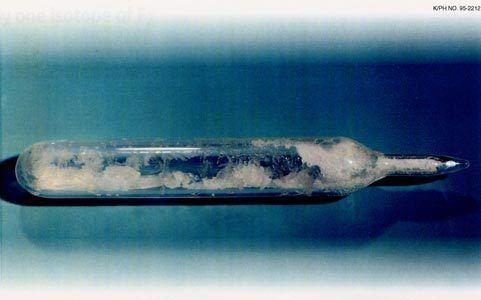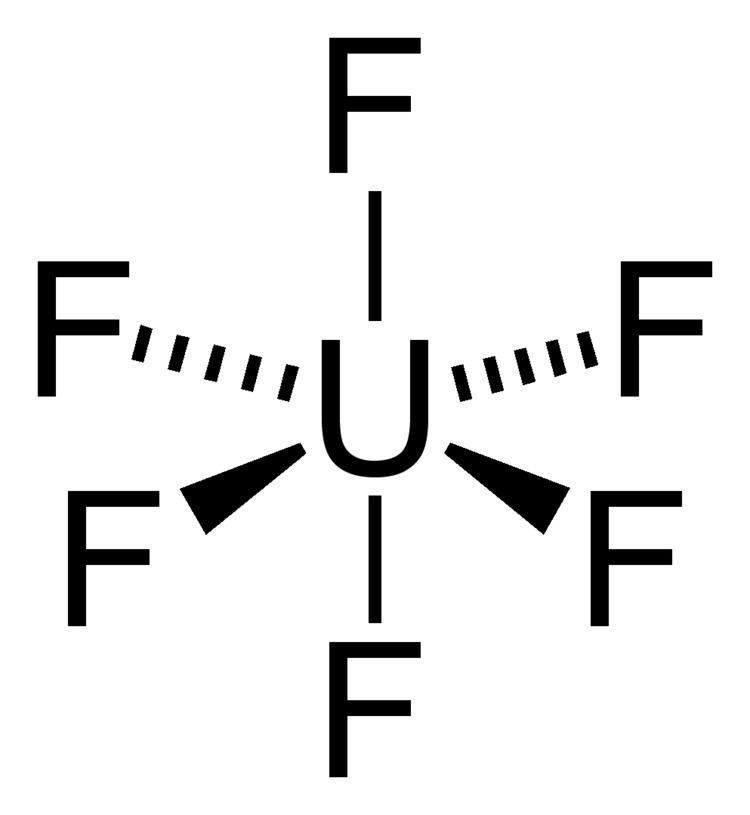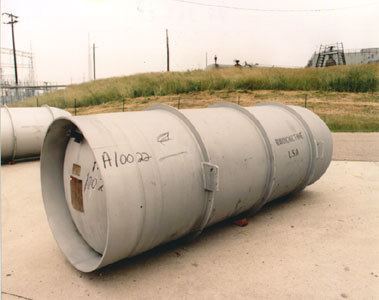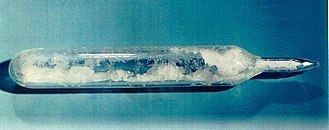Molar mass 352.02 g/mol Density 5.09 g/cm³ Melting point 64.05 °C | Formula UF6 Boiling point 56.5 °C Appearance colorless solid | |
 | ||
Related uranium fluorides | ||
10 27 2014 illinois radiation leak uranium hexafluoride gas leak from metropolis il
Uranium hexafluoride (UF6), referred to as "hex" in the nuclear industry, is a compound used in the uranium enrichment process that produces fuel for nuclear reactors and nuclear weapons. It forms solid grey crystals at standard temperature and pressure, is highly toxic, reacts violently with water and is corrosive to most metals. It reacts mildly with aluminium, forming a thin surface layer of AlF3 that resists further reaction.
Contents
- 10 27 2014 illinois radiation leak uranium hexafluoride gas leak from metropolis il
- Nuclear watch usa illinois uranium hexafluoride release at honeywell works 10 26 2014
- Preparation
- Physical properties
- Chemical properties
- Application in the nuclear fuel cycle
- Storage in cylinders
- Literature
- References

Nuclear watch usa illinois uranium hexafluoride release at honeywell works 10 26 2014
Preparation

Milled uranium ore—U3O8 or "yellowcake"—is dissolved in nitric acid, yielding a solution of uranyl nitrate UO2(NO3)2. Pure uranyl nitrate is obtained by solvent extraction, then treated with ammonia to produce ammonium diuranate ("ADU", (NH4)2U2O7). Reduction with hydrogen gives UO2, which is converted with hydrofluoric acid (HF) to uranium tetrafluoride, UF4. Oxidation with fluorine yields UF6.
During nuclear reprocessing, uranium is reacted with chlorine trifluoride to give UF6:
U + 2 ClF3 → UF6 + Cl2Physical properties
At atmospheric pressure, it sublimes at 56.5 °C.
The solid state structure was determined by neutron diffraction at 77 K and 293 K.
Chemical properties

It has been shown that uranium hexafluoride is an oxidant and a Lewis acid that is able to bind to fluoride; for instance, the reaction of copper(II) fluoride with uranium hexafluoride in acetonitrile is reported to form copper(II) heptafluorouranate(VI), Cu(UF7)2.
Polymeric uranium(VI) fluorides containing organic cations have been isolated and characterised by X-ray diffraction.
Application in the nuclear fuel cycle

UF6 is used in both of the main uranium enrichment methods — gaseous diffusion and the gas centrifuge method — because it has a triple point at 64.05 °C (147 °F, 337 K) and slightly higher than normal atmospheric pressure. Fluorine has only a single naturally occurring stable isotope, so isotopologues of UF6 differ in their molecular weight based solely on the uranium isotope present.
All the other uranium fluorides are nonvolatile solids that are coordination polymers.
Gaseous diffusion requires about 60 times as much energy as the gas centrifuge process: gaseous diffusion-produced nuclear fuel produces 25 times more energy than is used in the diffusion process, while centrifuge-produced fuel produces 1,500 times more energy than is used in the centrifuge process.
In addition to its use in enrichment, uranium hexafluoride has been used in an advanced reprocessing method (fluoride volatility), which was developed in the Czech Republic. In this process, used oxide nuclear fuel is treated with fluorine gas to form a mixture of fluorides. This mixture is then distilled to separate the different classes of material.
Storage in cylinders
About 95% of the depleted uranium produced to date is stored as uranium hexafluoride, DUF6, in steel cylinders in open-air yards near enrichment plants. Each cylinder contains up to 12.7 tonnes (or 14 US tons) of solid UF6. In the US alone, 560,000 tonnes of depleted UF6 had accumulated by 1993. In 2005, 686,500 tonnes in 57,122 storage cylinders were located near Portsmouth, Ohio, Oak Ridge, Tennessee, and Paducah, Kentucky.
The long-term storage of DUF6 presents environmental, health, and safety risks because of its chemical instability. When UF6 is exposed to moist air, it reacts with the water in the air to produce UO2F2 (uranyl fluoride) and HF (hydrogen fluoride) both of which are highly corrosive and toxic. Storage cylinders must be regularly inspected for signs of corrosion and leaks. The estimated lifetime of the steel cylinders is measured in decades.
There have been several accidents involving uranium hexafluoride in the US, including a cylinder-filling accident and material release at the Sequoyah Fuels Corporation in 1986. The U.S. government has been converting DUF6 to solid uranium oxides for disposal. Such disposal of the entire DUF6 inventory could cost anywhere from $15 million to $450 million.
